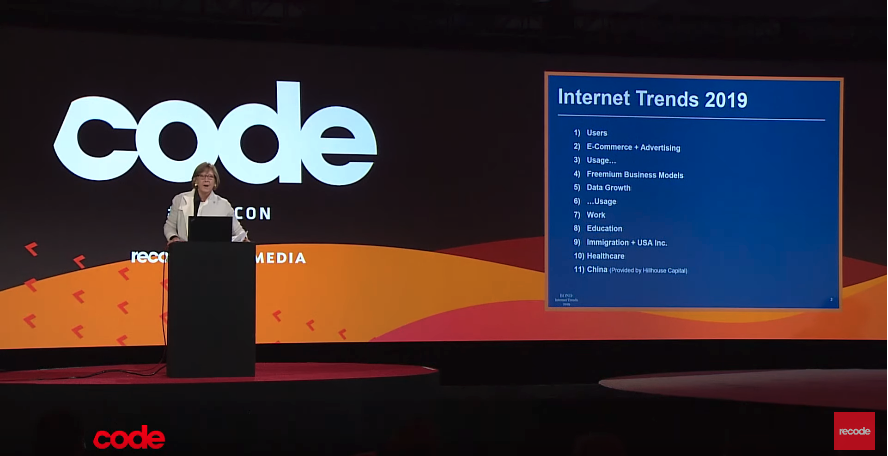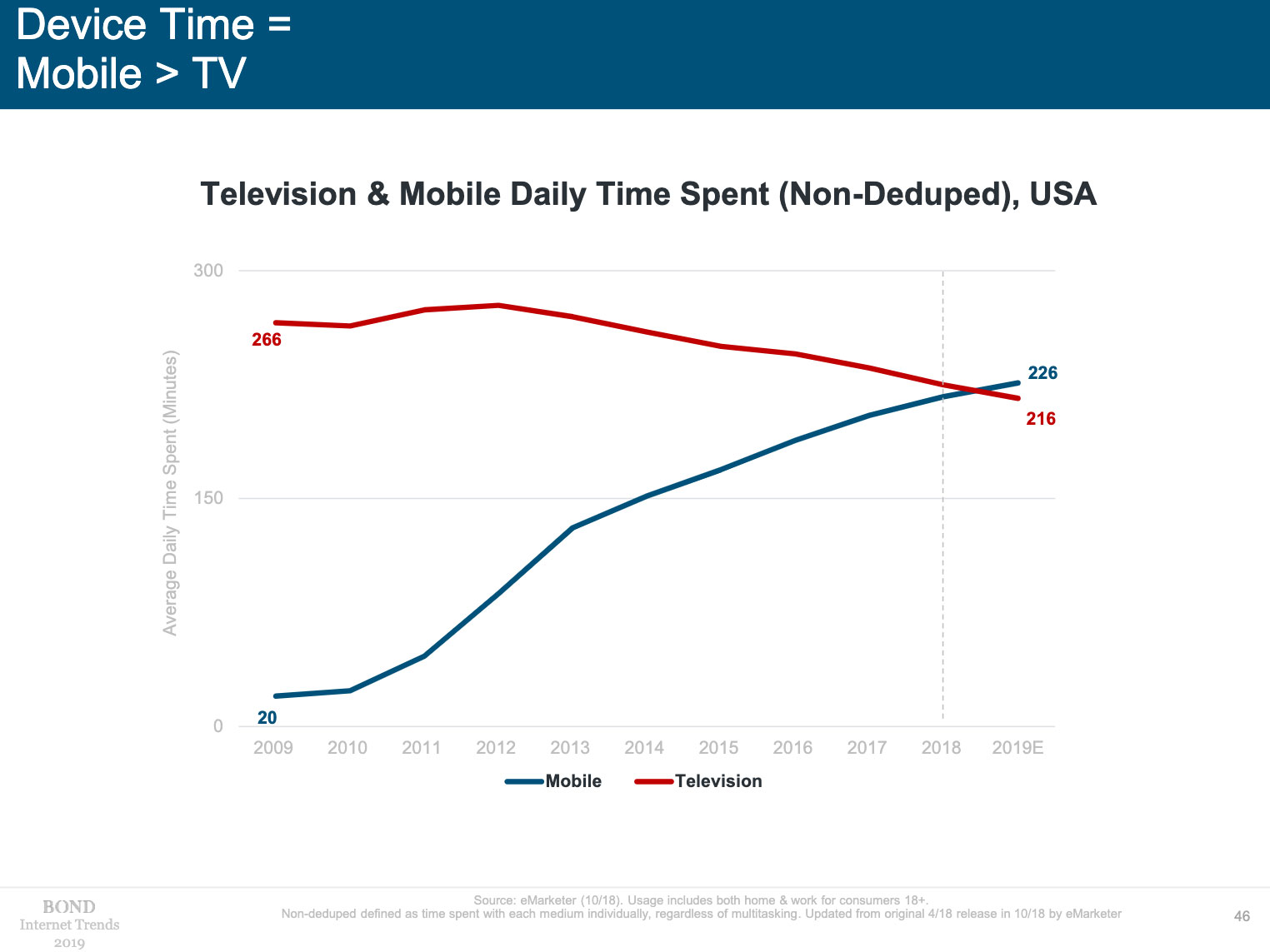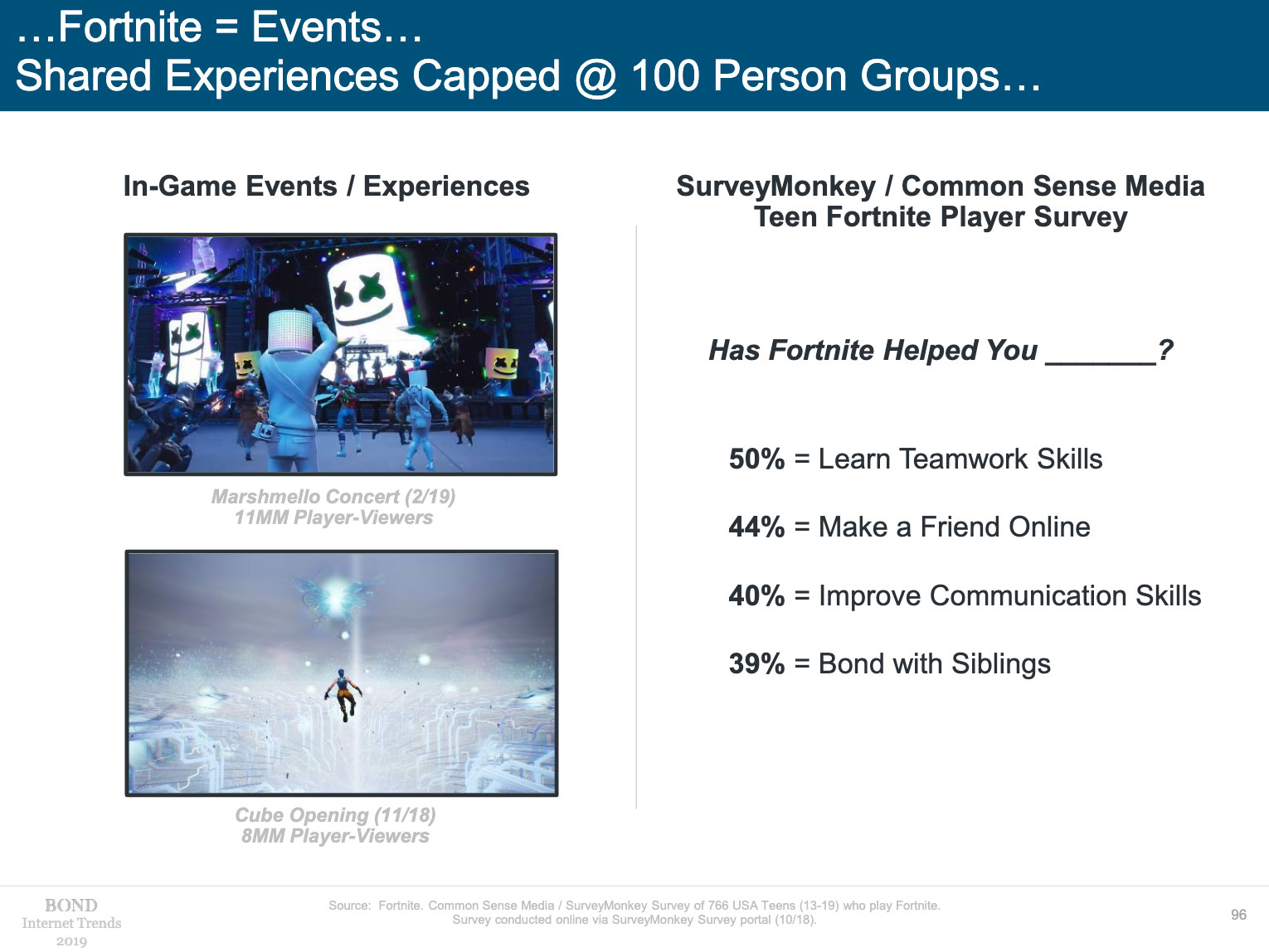Mary Meeker’s 2019 Internet Trends report (and why it matters to publishers)
Meeker’s annual slide deck always delivers, with tons of useful infographics and data. This year she offers no less than 333 slides. See highlights of 5 trends of note for publishers.
mary meeker, internet trends
https://www.youtube.com/watch?v=G_dwZB5h56E
At Recode by Vox’s 2019 Code Conference, Bond partner Mary Meeker released her highly anticipated slides, covering everything from ecommerce and advertising through business models and online behavior to immigration and what's happening in China. Meeker’s annual slide deck always delivers, with tons of useful infographics and data. This year she offers no less than 333 slides. You can download them here.
Here are five takeaways, along with insights for publishers:
1. Device Time = Mobile > TV
(Credit: 2019 Bond Internet Trends report, slide 46)
For the first time people are spending more time on their mobile devices than watching TV. Nielsen Q3 Total Audience Report shows that nearly half an adult's day is dedicated to consuming content. The data here shows a shift in the devices used to consume that content. And yes, we can still argue a case for the value of mass marketing to TV viewers, but we also need to acknowledge the shift in where time is being spent. A look at the share of daily time spent by platform shows variances by demographic, and the increases are in time spent on Internet-connected devices and app/web smartphone usage (no on linear TV).
Insight: Platforms like Netflix have created an audience with an insatiable appetite for content. The binge is an opportunity for publishers who can sell book to film/TV rights to these streaming services. Those publishers then need to be ready with solid SEO strategies so they can be responsive to viewers who are multitasking while watching. Meeker’s report shows that 88% of viewers report using a second digital device while watching TV. So we have fragmentation of channels and audience distraction. Great. The opportunity is to engage with those who are looking up content related to what they are watching.
Another short-term opportunity is that TV advertising, which has historically been prohibitively expensive, may become accessible in the form of digital TV-based advertising. That said, as viewers migrate from linear TV to streaming and digital services, more and more advertisers move into that space, crowd it up, make a lot of noise, and then end up escalating the costs to advertise.
And don’t overlook podcasts. Since 2014 podcast listening has also been increasing (slide 50). That’s not to say you should start a podcast. The market here is too crowded, but you can identify the podcasts worth supporting and tap into advertising and sponsorship opportunities.
2. Fortnite = Events … shared experiences capped at 100 person groups
(Credit: 2019 Bond Internet Trends report, slide 96)
Multiplayer video games such as Fortnite (250 million active users, most under age 17) are increasingly used by fans as a social networks. Fortnite is an online shooter game that starts with 100 players and ends with 1 winner. Through the game, players can talk and type whatever they want to each other. You can imagine where this goes, and why parents are freaked out (or should be).
The point here is that just as TV viewing varies by demographic, platforms such as Twitch (owned by Amazon) and Discord act as social media platforms for GenZ (those born 1997 onwards).
Games like Fortnite are how they connect to each other, form community, test out their identity, and practice teamwork and communication. These are true digital natives. They dream of being YouTube stars.
And, perhaps alarmingly, a growing number of people report being online almost constantly with 39% of 18-29 year olds reporting they rarely disconnect from the internet.
Insight: Publishers running YA and teen reading groups need to meet their audience where they are, and it’s not in Facebook Groups. If your audience is under age 22 then it’s time to look at platforms like Twitch, and to find influencers on these platforms who can be the conduit for your message. The caveat being that your pitch can’t be a hard sell. Go back to that audience-centric handselling model and be conscious of what is worth sharing. And for the love of money, work with influencers based on engagement, not audience size.
Please know games are not just young people. Remote workers, freelancers, and the self-employed enjoy the flexibility of work-life that’s possible with chat and conferencing tools like Slack and Zoom. Their familiarity with being connected online to small work groups is not really any different than being on a team of 100 playing Fortnite.
Keep this in mind through the rest of the post: Mobile gaming, ecommerce, and influencer marketing are scaling quickly in China, moreso than in the West. The Iron Curtain and the Cold War are transitioning to the Digital Curtain and the Tech War.
3. Image Sharing = Foundations Continue to Ramp
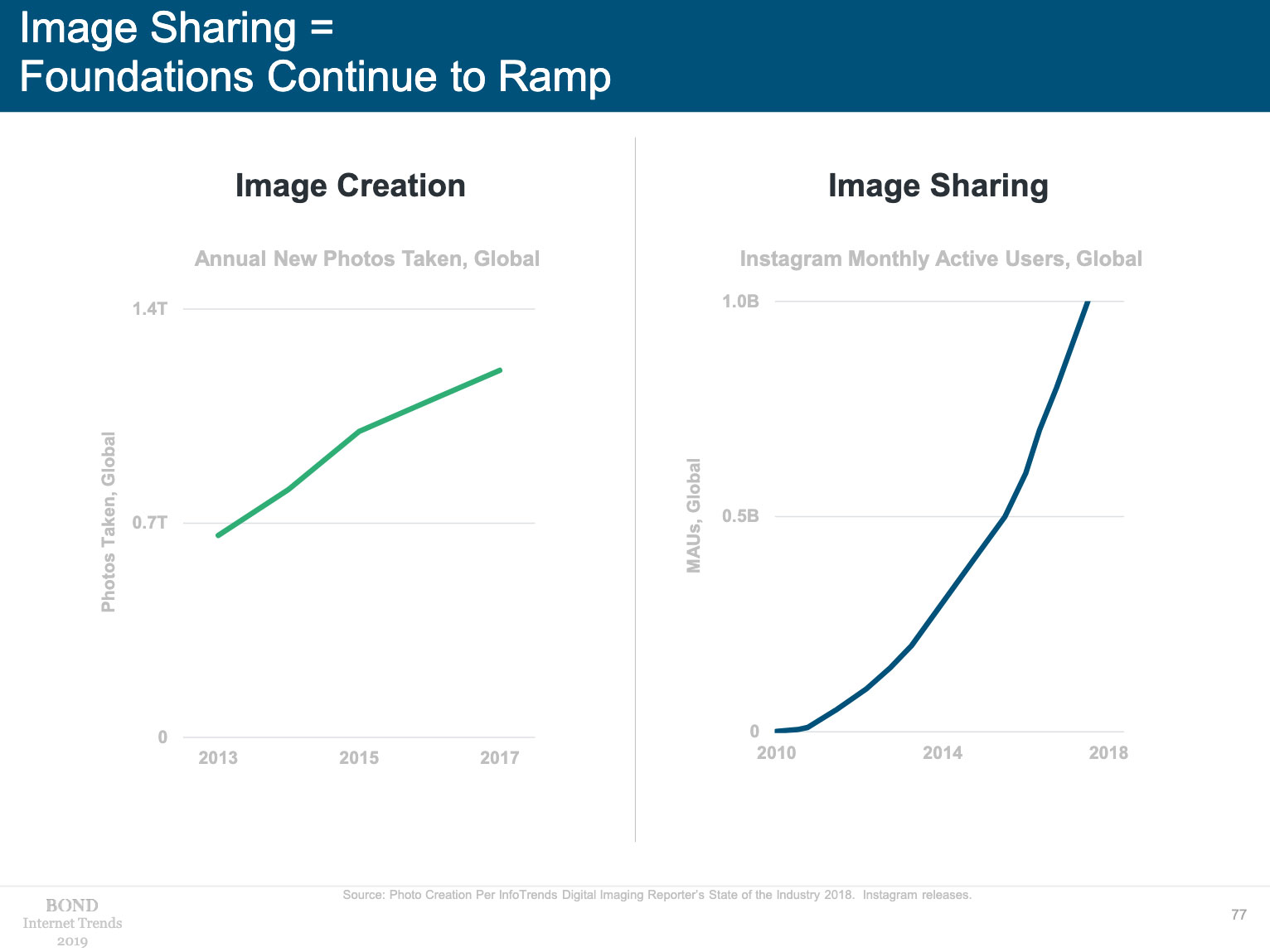
(Credit: 2019 Bond Internet Trends report, slide 77)
Image sharing is not just for Pinterest. More than 50% of all tweets, for example, now include images. YouTube and Instagram are the platforms seeing the most gains. And, as Meeker notes, an increasing number of people are using images to communicate. We are back to cave drawings. Some people even claim they have forgotten how to read.
Insight: Images and emojis are forms of self expression. On the one hand, they are the temporary tattoos of the day. Short, micro videos like those on TikTok or Instagram Stories feed the imagination, act as memes, circulate and fade quickly away. On the other hand, these visuals transcend language. And marketers with design fluency and storytelling are winning the day. Social media algorithms are primed to reward image and videos posts with greater reach and engagement. Tap that opportunity while it’s available.
And for publishers more comfortable on Instagram, (slide 79) shows how this platform is becoming a shopping platform. We’re in a time where the lines between search, social, and ecommerce are blurred. Don’t wait this one out.
4. Internet Ad Platforms = Google + Facebook Lead But Others Gaining Share
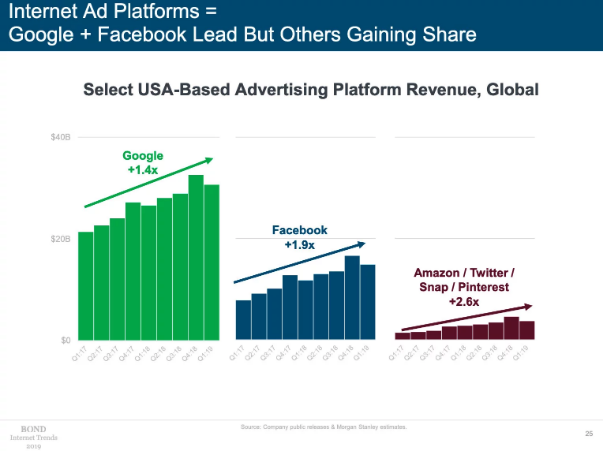
(Credit: 2019 Bond Internet Trends report, slide 25)
Meeker’s Internet Trends report shows new platforms are emerging for Internet ad spending. In particular, Amazon Twitter and Pinterest collectively saw 6x year-over-year growth since 2017.
Insight: Yes, Google and Facebook lead and continue to see steady growth. But it’s more and more expensive to advertise here, and the effectiveness wavers. Publishers are already experimenting with Amazon's ad platform, which is up 2.6x in Revenue.
Amazon's competitive moves in the marketplace should be of note for publishers. I believe what Amazon is preaching in that they have a captive audience ready to click buy, unlike Google and Facebook where their audience is in research, explore, or entertain me mode.
Here are two points in Meeker’s report that stand out to me: 1) customers spend more time than ever on digital media—3.6 hours per day—and 2) ecommerce contributes to 15% of all retail sales (slide 20). I’d put my money on the platform with a captive audience ready to click buy. Do the title/author awareness and engagement campaigns on Instagram, but back it up with conversion campaigns on Amazon.
5. Digital Media = Encrypted Messaging / Traffic Rising Rapidly
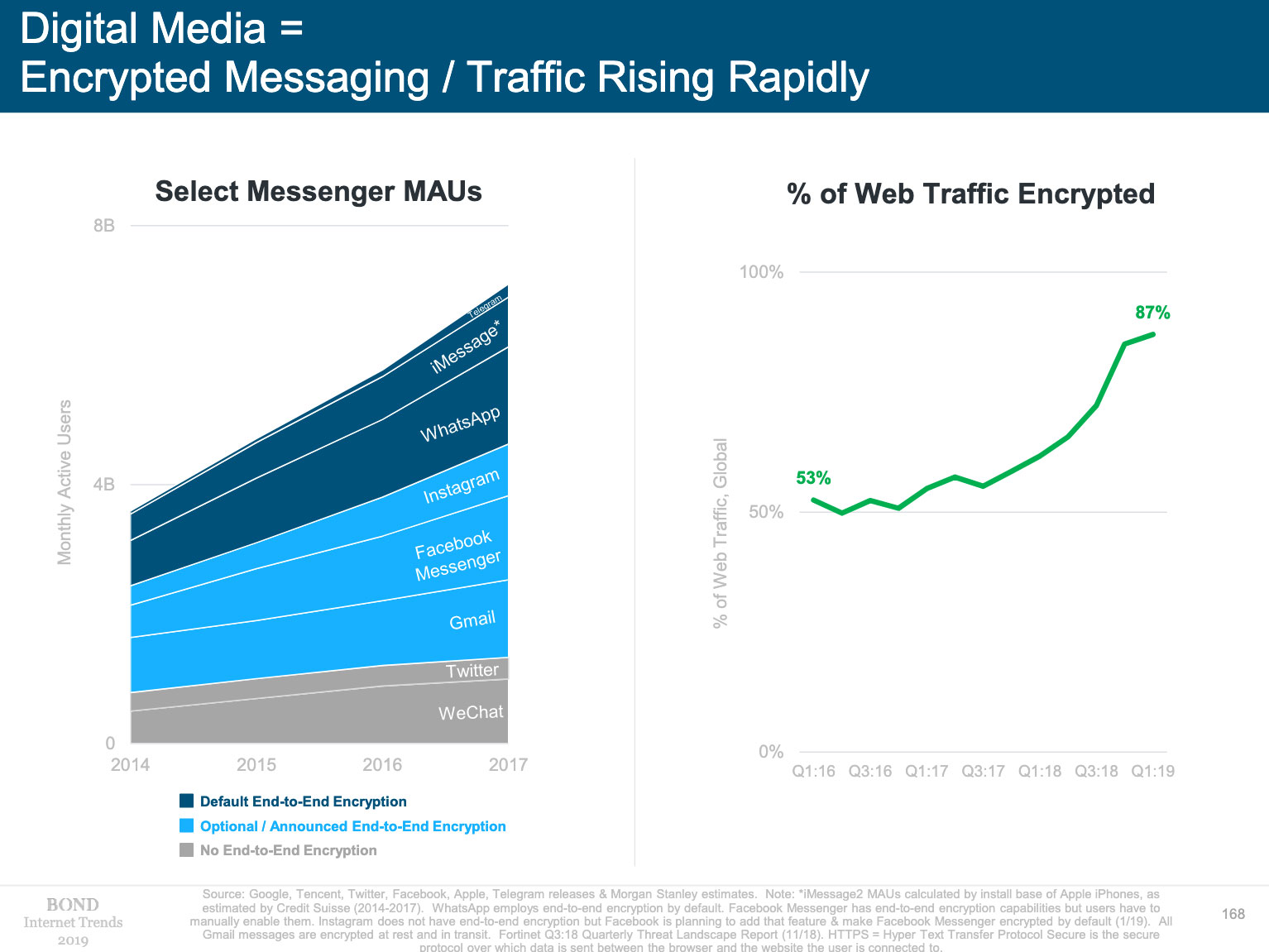
(Credit: 2019 Bond Internet Trends report, slide 168)
Messaging platforms offering encryption and secured services like Telegram and WhatsApp are outpacing non-encrypted messaging services like WeChat. There’s a privacy war on, and consumers are tired of being data mined.
At the start of 2019, 87% of web traffic was encrypted compared to just 53% in 2016. Why is that important? As more content is shared on dark social—via encrypted chat or private channels that are not indexed by search or where referral information about the source is not trackable—marketers lose sight of which channels are effective. Like with gaming, the best play here might be for publishers to build relationships with influencers in these private spaces who have the power to impact the purchase behaviour of their community.
What’s next?
1. Download Mary Meeker's 2019 Internet Trends Report (full deck): https://www.bondcap.com/report/itr19/
2. See Vox’s recap of the most significant trends in Meeker’s report: https://www.vox.com/recode/2019/6/11/18651010/mary-meeker-internet-trends-report-slides-2019
3. Watch China. Meeker’s report shows (slide 10) that most internet growth is in Asia, specifically the Asia-Pacific region. Watch the tools developed by ByteDance. In particular familiarize yourself with short-form video (TikTok) and be aware of the super apps that are more evolved that what we’re familiar with in North America and Europe. Meituan and other innovative apps (slide 318) are examples of these super apps that combines 10+ Western apps into the same super app.
In closing, my favourite digital companies Meeker mentions, and that I use, are Canva, Slack, Stripe, Spotify, Dropbox, and Zoom. I’m fascinated by Discord, Twitch, and Stitch Fix, plus China’s Alipay, and their retail models and options for ecommerce and payments (slide 65).

